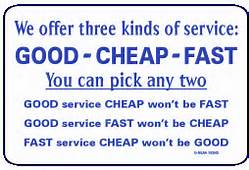So the Imaging RFP is out and there are no fixed parameters, no volumes, no index requirements and no document types listed. You are on the client / vendor call listening to all the questions being asked when you hear …”well you guys are the experts – you tell us!”
It is difficult to do and I have by no means mastered the art of gently pushing back on the client. But, is it wrong to ask the Client to consider providing defined parameters around their imaging project so when comparing vendors they are comparing apples for apples? After all you want to be their trusted partner and you are already helping them out of the gate create a level playing field for themselves to review each vendors solution and pricing equally. Let me expand a little further……
Without defining a set volume, number of document types, index fields required then the resulting proposals will vary drastically:
– Some will low ball it to get the work and potentially not deliver as they have gone too low
– Some will low ball it to win the business but then have numerous Project Change Requests (PCRs) which will drive up the final cost
– Others will be risk averse and make worst case assumptions thus driving up their price
– Others will be unsure about the work or not want it as the project is so open-ended and with their strong brand reputation go in high
I am sure this applies to many projects in the ECM / BPM space but I think with imaging it may be a little easier to raise the question for open-ended projects. Interested to hear other people’s views and experiences.






